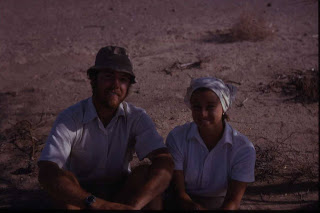A species of Nothobranchius collected by us from south of Lamu, Kenya
Many of these killifish live in temporary pools, and the adults die when the water dries up. The next generation rests as eggs in the mud, and hatch when the rains return. This gives them the name "annual fishes". Above are some annual killies from elephant pans in coastal Kenya, north of Malindi.
Susan taking photographs in Kenya National Museum.
Industrialization of parts of Africa, and the clearing of forests for their hardwoods and for agriculture, have sent many species to the verge of extinction.
For example, this is, or was, the Karura Forest near Nairobi in Kenya in 1972. Today it is gone, felled for its hardwoods. A reforestation effort is under way, but it will take about 200 years to restore the forest. By that time, many animal species that depended on the forests will become extinct. Meanwhile Kenya faces terrible droughts, because they have removed the large trees that tap the groundwater and return moisture to the atmosphere above them.
Lately I've started to keep a few killifish species again. I have a light teaching schedule as retirement looms. I've rejoined an aquarium club that preserves them, selected a few species to keep, and filled a small room in the basement with aquaria. There is a lot to relearn, and keeping these colorful fish is very labor labor intensive. Just the thing for an old professor.
At present we keep fish from West Africa: Aphyosemion australe "the golden lyretail" from Gabon, Fundulosoma gardneri from Makurdi in Nigeria, Aplocheilus (Epiplatys) dageti, and Aphyosemion primagenium. The first three are commonly kept, the latter is my preservation project.
A trip today to the fish room resulted in pictures of the first two species.
Above is a photo of a male Fundulosoma gardeneri from Makurdi, Nigeria.
He is looking at his reflection.
and here is a pair of Aphyosemion australe, the xanthic form.
The female in the foreground is less colorful.
In each tank there are a few floating plants, a box filter, and a yarn mop for collecting eggs.
Here is a rough video of the fish we keep.
Notice: All of these posts and photos are copyrighted, with all rights reserved. Hundreds of friends and relations have seen the Africa photos and heard the stories, and read published versions of them on other sites.






I found your blog while searching YouTube for fish room videos and found it very interesting.
ReplyDeleteI noticed in the video that you use box filters with gravel in them. I'd like to see a post on these. Why you do it this way and how you maintain them.
Some posts on your live food cultures would also be of interest.
Thanks for blogging and keep up the good work.
These are PennPlax box filters from Walmart. We prefer them because of their small size.
DeleteThe gravel filters out solid waste and sets up a biological filter. We learned this technique from the writings of Rosario LaCorte.
If we have young males, we include a layer of loose wetted peat moss. It contains chemicals that help the male gonads to mature.
The peat moss gets losse and falls around the tank floor, but that's okay. Many of these fish are from "black water" streams and swamps.
In the aged water tank (55 gallons) there are additional bunches of peat moss. The peat moss also discourages fungus.
Just testing to see if my e-mail change worked.
ReplyDelete